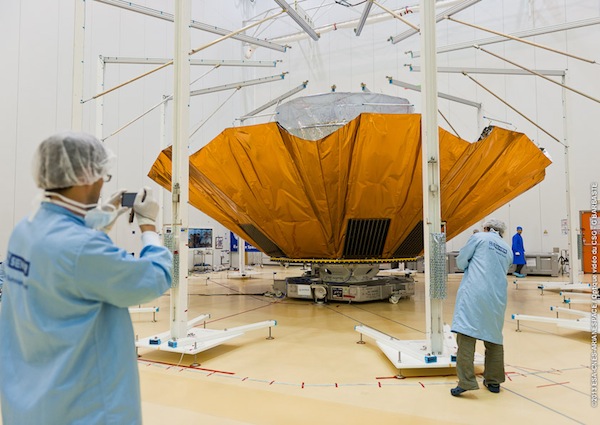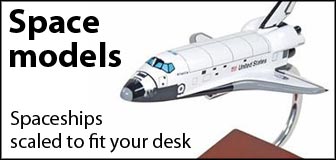Gaia sunshield passes final exam
BY STEPHEN CLARK
SPACEFLIGHT NOW
Posted: October 15, 2013
Working inside a climate-controlled clean room in the tropical French Guiana rainforest, technicians have completed final assembly and checkout of the European Space Agency's Gaia spacecraft before it blasts off in November on a quest to map more than a billion stars.
The testing reached a climax last week when workers unfolded Gaia's insulating sunshield, a circular layer of insulation stretching more than 34 feet in diameter. The shield keeps Gaia's sensitive camera, the largest ever flown in space, at a chilly minus 148 degrees Fahrenheit for its five-year mission.
Gaia will measure the brightness and location of more than a billion of the brightest stars in the sky, plotting their movements and allowing astronomers to study the evolution of the Milky Way galaxy.
With the sunshield unfurled, Gaia covers an area the size of half of a tennis court. The sunshield folds up like an umbrella for launch, fitting inside the 13.5-foot diameter of the payload fairing for the mission's Russian Soyuz launch vehicle.
Gaia will deploy the sunshield shortly after separating from the Soyuz rocket's Fregat upper stage. Launch of the $1.2 billion mission is scheduled for Nov. 20 at 0857 GMT (3:57 a.m. EST) from a Russian-operated launch pad at the French-owned Guiana Space Center.
Arianespace will oversee the launch as the Soyuz rocket's commercial marketing firm.
When extended 90 degrees into its flight position, Gaia resembles the shape of a wide brim hat - its disc-shaped sunshield making up the visor and the observatory's main body in the middle.
The sunshield deployment was conducted with the help of a test rig to compensate for gravity since Gaia was unfold the sunshield in space.
"Gaia is made up of two telescopes which need to be extremely stable, so the purpose of the sunshield is to keep the full spacecraft and the payload in the shade," said Giuseppe Sarri, Gaia's project manager at the European Space Agency.
Engineers also designed Gaia to be stationed at the L2 Lagrange point about a million miles from the night side of Earth, a thermally-stable position where gravity from the Earth and sun balance a satellite's motion.
Officials shipped the Gaia spacecraft and its sunshield to French Guiana on separate cargo flights from Europe in August. Since the components arrived at the equatorial space center, technicians bolted the sunshield on Gaia and carefully ensured it would deploy as designed.
The sunshield is made of 12 frames of carbon fiber tubes hinged at the base of the spacecraft. The frames are covered with gold multilayer insulation blankets.
The sunshield was designed and manufactured by SENER of Spain. RUAG Aerospace of Austria provided the sunshield's insulation, and the carbon fiber backbone comes from RUAG Aerospace of Switzerland.
EADS Astrium of France is the prime contractor for Gaia.
Because Gaia will always point away from the sun, the underside of the sunshade is also a mounting point for some of Gaia's electricity-generating solar panels.
Preparations of Gaia's Soyuz rocket are ahead of schedule at the European-run spaceport in South America. The rocket's Fregat upper stage, which will fire to send Gaia toward its distant operating post, is fueled and awaiting its attachment to the 4,475-pound spacecraft.
The Soyuz rocket assigned to Gaia was originally designated to launch a quartet of broadband communications satellites for O3b Networks. The O3b launch was pushed back to early 2014 to resolve a problem with the satellites.
Gaia took over O3b's Soyuz rocket, named VS06 in the Arianespace launch sequence, in the aftermath of the postponement. The Gaia mission retained its specially-modified payload fairing because it required the removal of some layers of thermal coating to accommodate tight clearances between the shroud and the Gaia spacecraft.
According to Sarri, Gaia should be in its final flight configuration by the end of this week. Fueling of the spacecraft, a three-day operation, is due to begin Nov. 2.
Gaia will be transported to another clean room at the French Guiana space base for integration with the Russian Fregat upper stage Nov. 8, with encapsulation inside the Soyuz rocket's "ST-type" clamshell-like payload fairing to follow Nov. 13.
The Soyuz rocket will be towed 600 meters, or about 2,000 feet, from its assembly building to the launch pad approximately four days before launch, then lifted vertical for attachment of Gaia and the Fregat rocket stage inside the payload shroud.
 Credit: ESA-CNES-Arianespace/Optique video du CSG-G. Barbaste Credit: ESA-CNES-Arianespace/Optique video du CSG-G. Barbaste
 Credit: ESA/M. Pedoussaut Credit: ESA/M. Pedoussaut
 Credit: ESA-CNES-Arianespace/Optique video du CSG-G. Barbaste Credit: ESA-CNES-Arianespace/Optique video du CSG-G. Barbaste
 Credit: ESA-CNES-Arianespace/Optique video du CSG-G. Barbaste Credit: ESA-CNES-Arianespace/Optique video du CSG-G. Barbaste
 Credit: ESA-CNES-Arianespace/Optique video du CSG-G. Barbaste Credit: ESA-CNES-Arianespace/Optique video du CSG-G. Barbaste
 Credit: ESA-CNES-Arianespace/Optique video du CSG-G. Barbaste Credit: ESA-CNES-Arianespace/Optique video du CSG-G. Barbaste
 Credit: ESA/M. Pedoussaut Credit: ESA/M. Pedoussaut
 Credit: ESA/M. Pedoussaut Credit: ESA/M. Pedoussaut
 Credit: ESA/M. Pedoussaut Credit: ESA/M. Pedoussaut
 Credit: ESA-CNES-Arianespace/Optique video du CSG-G. Barbaste Credit: ESA-CNES-Arianespace/Optique video du CSG-G. Barbaste
|


 Credit: ESA-CNES-Arianespace/Optique video du CSG-G. Barbaste
Credit: ESA-CNES-Arianespace/Optique video du CSG-G. Barbaste Credit: ESA/M. Pedoussaut
Credit: ESA/M. Pedoussaut Credit: ESA-CNES-Arianespace/Optique video du CSG-G. Barbaste
Credit: ESA-CNES-Arianespace/Optique video du CSG-G. Barbaste Credit: ESA-CNES-Arianespace/Optique video du CSG-G. Barbaste
Credit: ESA-CNES-Arianespace/Optique video du CSG-G. Barbaste Credit: ESA-CNES-Arianespace/Optique video du CSG-G. Barbaste
Credit: ESA-CNES-Arianespace/Optique video du CSG-G. Barbaste Credit: ESA-CNES-Arianespace/Optique video du CSG-G. Barbaste
Credit: ESA-CNES-Arianespace/Optique video du CSG-G. Barbaste Credit: ESA/M. Pedoussaut
Credit: ESA/M. Pedoussaut Credit: ESA/M. Pedoussaut
Credit: ESA/M. Pedoussaut Credit: ESA/M. Pedoussaut
Credit: ESA/M. Pedoussaut Credit: ESA-CNES-Arianespace/Optique video du CSG-G. Barbaste
Credit: ESA-CNES-Arianespace/Optique video du CSG-G. Barbaste
